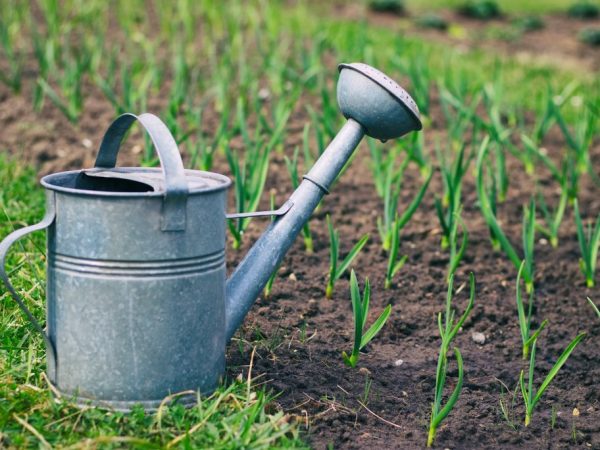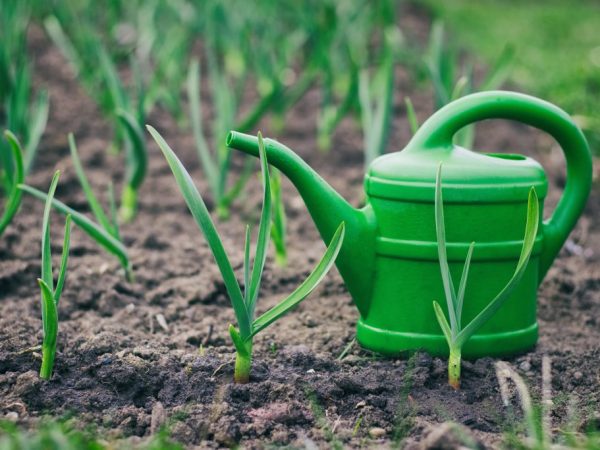Rules for watering garlic in spring
Spring is a changeable time. Heavy rains are followed by drought or prolonged frosts. But gardeners who grow winter garlic are not afraid. It is resistant to temperature and weather changes. But not everyone knows how to water the garlic in spring and not harm the plant.

Rules for watering garlic in spring
The correct watering time must be selected. It is necessary to carry out the main and additional (on demand) feeding. Together, these actions will help you grow a tasty and high-quality crop.
Preparing for watering
The winter variety emerges early. In early spring, after the autumn planting, the first shoots appear. Care should be started when the snow melts.
- First, the soil is loosened. Remove the top soil crust that has developed after the winter period. It closes the access of oxygen to the sprouts. Surface loosening is necessary to a depth of 3-5 cm. It is carried out using a garden tool with 3 teeth or a narrow hoe. Loosening deep is not worth it. This will damage the root system and sprouts.
- The next step is mulching. Initially remove all weeds at the planting stage and before this procedure. This contributes to the even distribution of water, the elimination of excess moisture in the ground. Reduces the number and frequency of weeds. Prevents the plant from freezing in severe frosts. Peat, sawdust, mulch paper, peat, dry grass are used as mulch. The best material is straw.
General rules
The first watering is carried out immediately after loosening. If there was natural precipitation, the procedure should be postponed to the next day. The main rule is orientation to weather conditions. If the spring is hot, the amount of water will increase. Reduce if cool and rainy.
Approximate doses of watering:
- At a temperature of 13-18 ° C, 10-12 liters of water are enough per 1 m2. The break between watering is up to 10 days.
- If the temperature is 18-25 ° C, the amount of water is 10-12 liters. The interval between procedures is reduced to 3-4 days in two weeks.
- The presence of rainy weather and unstable temperature conditions affects the decrease in the number of irrigations. The main thing is not to overmoisten the soil and not to destroy the vegetable crop.
Until May, garlic is watered only if necessary. From May to June this is a mandatory procedure.
Stop watering the plant 20 days before harvest. This will increase the shelf life of the crop.
Gardeners advise to water the garlic using drip irrigation. An excellent solution during a drought. It reduces the risks of plant disease or decay.
Watering with solutions
Not everyone knows that watering young garlic in the spring can be done with a solution of potassium permanganate. Saline solutions will help improve the quality of the soil and saturate it with useful minerals.
Salt is used if you need to scare off pests. Especially - onion fly and nematode. Saline recipes:
- For onion flies - 250 g per 10 liters of warm water. It is necessary not to water, but to spray. After it, the shoots are watered with plain water. Expect an increase in the number of arrows.
- From root nematode - 2 tbsp.spoons per 10 liters of water. This is enough for a 2 m2 garden bed. It is necessary to water the plant with clean water. Repeat the procedure after 10 days.
You can find out that you need to add a saline solution from the yellowed leaves. This is the first sign of the negative impact of pests.
Potassium permanganate is used if the arrows develop poorly, and the shoots quickly turn yellow. It is brought in before planting for the winter. But you can water the beds with a solution in early spring.
Feeding rules

We feed garlic with water and dressing
Garlic care is simple and includes feeding. Inexperienced vegetable growers often wonder how to water and feed garlic in spring.
With the help of water, you can saturate winter garlic with nutrients. You will need special fertilizers. They can be purchased at a specialty store or made at home.
They begin to feed the soil in early spring - from late March to early April. For garlic planted for the winter, phosphorus and potash fertilizers are used. They promote better germination of the bulbs. Increases the amount of carbohydrates and proteins in the cloves.
Stages
Liquid fertilizer should be applied gradually. The correct order is the key to the success of the gardener.
Main steps:
- Feeding with urea.
- Use of nitrophoska and nitroammophoska. Diluted in a bucket of water. 3 liters of solution per 1 m2 is enough.
- The use of superphosphate. Take 2 tbsp. spoons for 10 liters of water.
It is important to adhere to this order. Then the plant will grow and develop gradually and correctly.
Fertilizing products
Not everyone knows how to water garlic in spring in order to get a high-quality harvest. The optimal solution is to combine watering and feeding. They are carried out in parallel. If you need ordinary water for irrigation, then special means for fertilization. They are divided into organic and mineral.
Organic fertilizers
Their main advantage is free access and low cost. They improve the soil, which affects the growth of the plant. Increase water resistance, moisture capacity. Sufficient for several seasons (from 1 to 5 years).
The main task of the gardener is to correctly calculate the proportions of the fertilizer components. It is necessary to follow the rules for the introduction of nutrients. Otherwise, there will be no expected result.
Manure
Cow or horse manure is one of the best organic fertilizers for all plant species. Improves the quality of the soil, which promotes the rapid growth of garlic.
Apply 30-40 tons per 1 ha or 4-5 kg per 1 m2 three times during the growing season, depending on the state of the soil. Must be rotted and liquid. The ratio of water and manure is 1: 6.
The consequences of an overabundance are an increase in the amount of nitrogen in the garden. It saturates the vegetable crop with nitrates, which are harmful to the human body.
Urea
This fertilizer contains nitrogen. Quickly absorbed by winter garlic. After 2 days, the amount of protein in it will increase. It is introduced in the cold spring first. Does not burn sheet plates.
Recipe:
- Dilute 1 tablespoon of urea in 10 liters of water.
- Expect complete dissolution.
- 3 liters of solution per 1 m2.
It is not worth saving the solution. Do it just before use.
Urea added in the spring will improve the quality of the crop. In a hot summer, it will save the crop from drying out and saturate it with useful substances.

Urea from drought
Mineral fertilizers
Garlic does not always have enough natural mineral inorganic. To increase their number is why mineral fertilizers are needed. Their use will help improve the condition of the soil, make the plant resistant to diseases and shorten the germination time of the cloves.
Nitrogen
The main component is ammonia. On its basis, ammonium nitrate is made. Must be applied before bulb formation begins in early spring. Promotes rapid leaf and root growth.
Proportions: 1 tbsp. a spoonful of ammonium nitrate in 7 liters of water. This is enough for 1 m2.If the weather is hot, increase the amount of water to 10 liters.
Potash
Their main function is to make garlic more resistant to disease. Extends the shelf life of the product. They are rarely used in pure form. Potassium salts should be combined with trace elements (copper, magnesium, iron).
The norm of salts is 30-45 g per 1 m2. If potash fertilizer is mixed with others, then its amount does not exceed 15 g / m2.
Phosphoric
These are energy sources. They control metabolic processes. They help to better assimilate the incoming minerals and other useful components.
They are used in cases:
- purple shade of leaves on sprouts;
- changing the shape of the sheets;
- the appearance of dark spots along the entire length of the plant;
- poor development of the root system.
The most famous phosphate fertilizer is superphosphate. The required amount is 2 tbsp. spoons in 1 bucket of water. Increases the resistance of onion crops to temperature and weather changes. Thanks to him, the yield increases by 2-3 times.
Complex fertilizers
Nitrofoska is a substance that contains nitrogen, potassium and phosphorus. To find out how much is needed, just check the condition of the soil. Under normal conditions, 2-3 liters of solution per 1 m2 is sufficient. The amount of solution is 2 tbsp. spoons for 10 liters of water.
Fertilizer promotes better germination of onion crops and growth of the root system. Increases the formation of cloves and bulb mass.
Conclusion
Gardeners often wonder how to water winter garlic in spring. The first watering of young winter garlic is an important step in proper care, the main thing is to wait for the frost to recede. It is important not to overmoisten the soil or leave it dry.
It is best to water the onion plant with ordinary water once a week at 18-25 ° C. In hot weather - three times a week. To do this, use potash, phosphorus, nitrogen fertilizers in liquid form. Their main function is to improve the quality of the crop and extend the shelf life.


